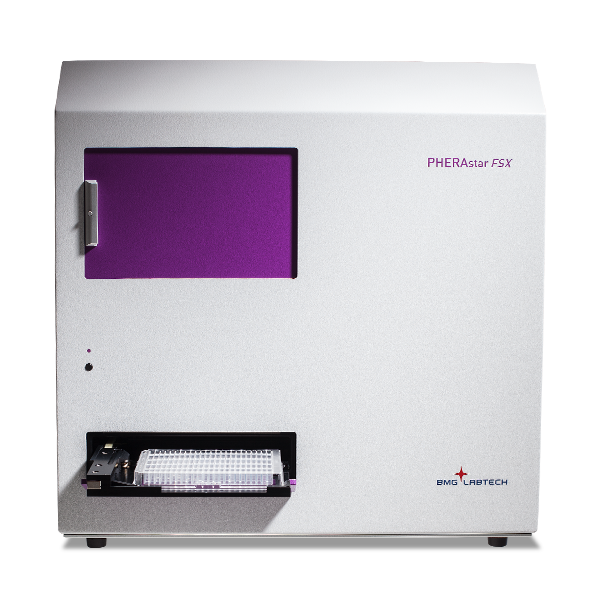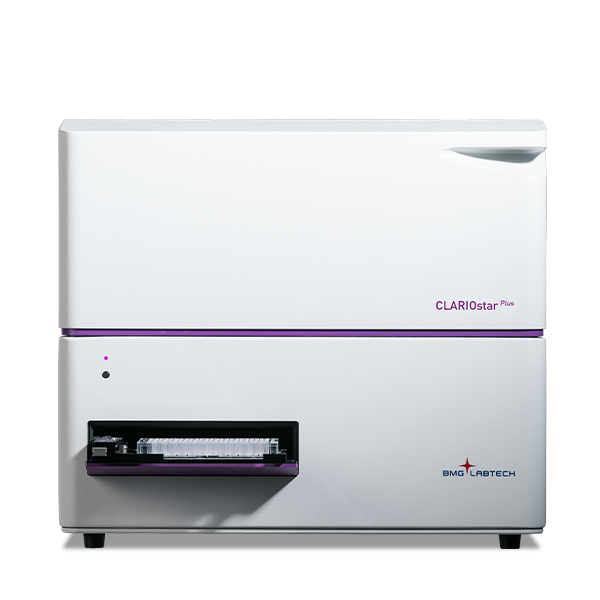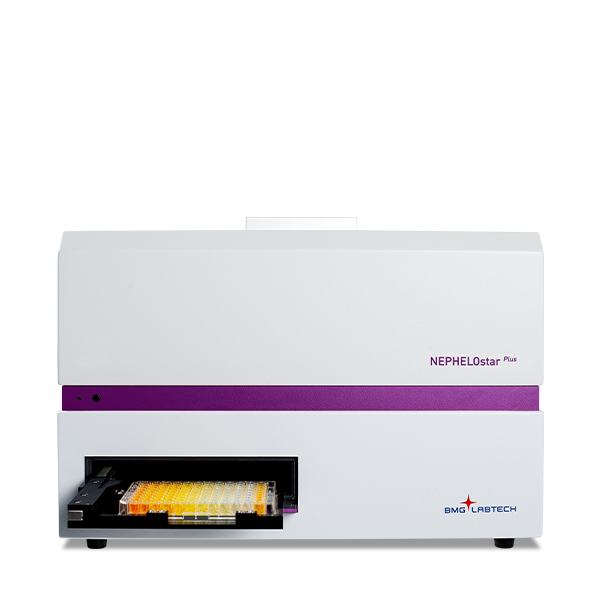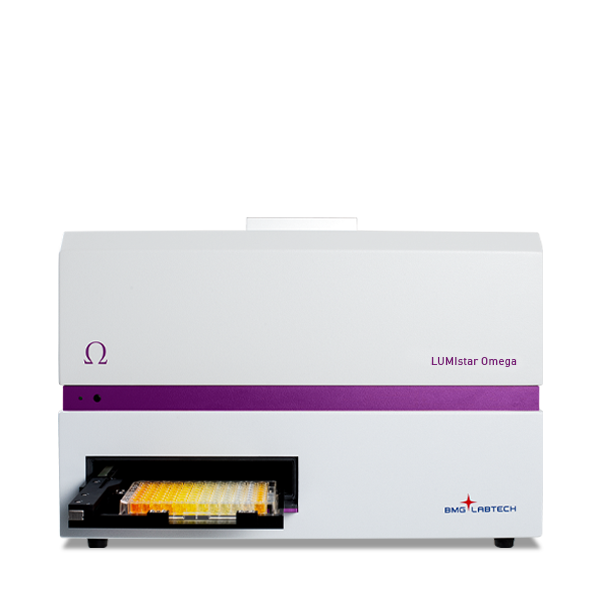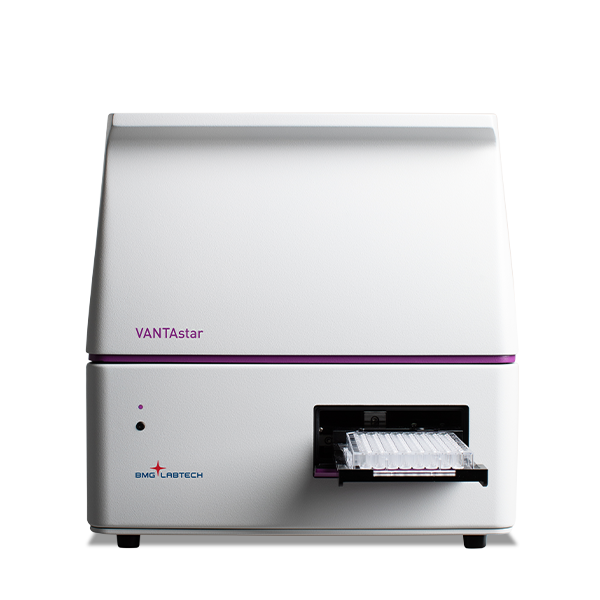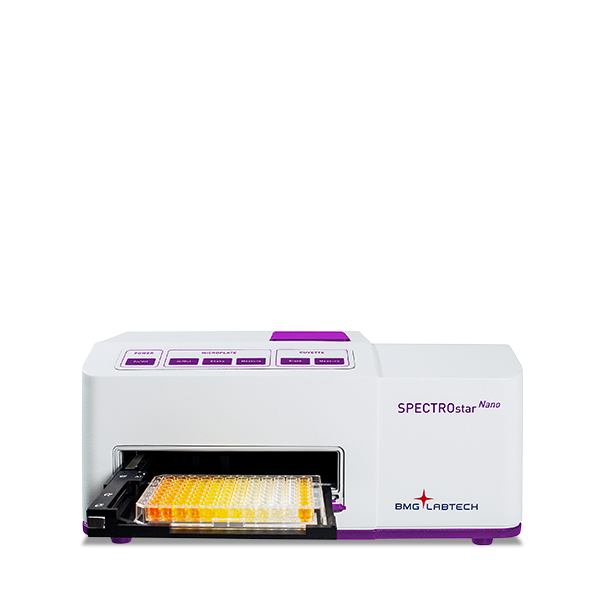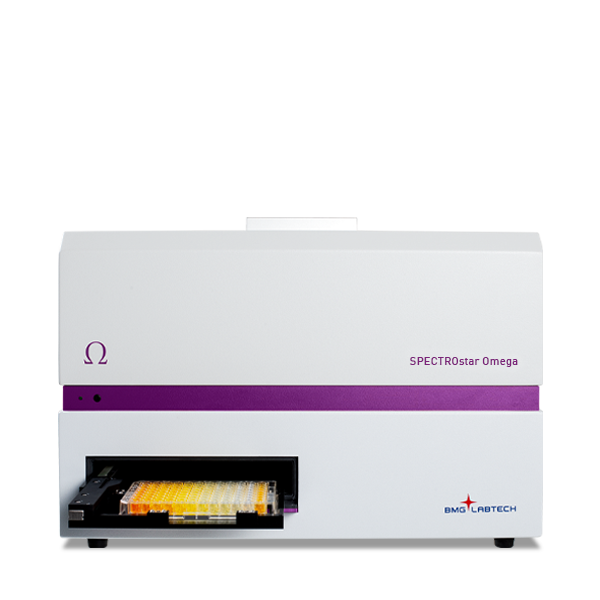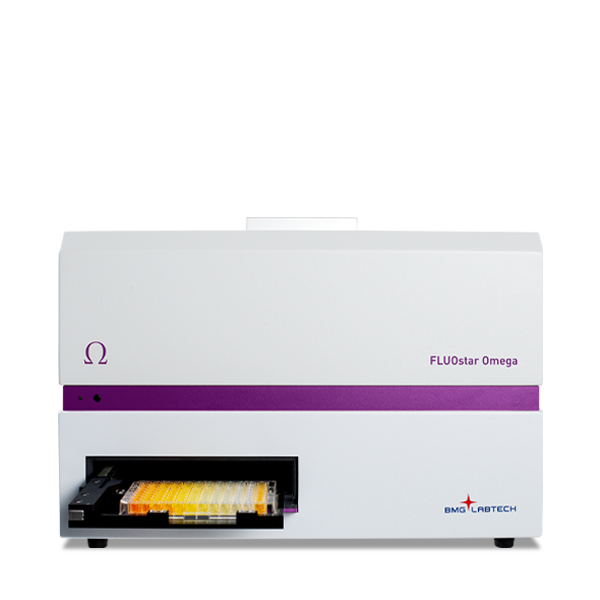
An absorbance microplate reader, (absorbance plate reader, absorbance microplate spectrophotometer or absorbance reader), is a piece of equipment capable of detecting and quantifying the light photons absorbed/transmitted by a liquid sample present in a microplate, when exposed to light at a specific wavelength.
As opposed to fluorescence and luminescence, absorbance detection is an absolute measurement quantified in Optical Densities (ODs). OD is defined as the logarithmic ratio between the intensity of light hitting a probe and the intensity of the light transmitted through it. Alternatively, transmission, the portion of light that passes the sample, can also be used.
Absorbance microplate readers, also called spectrophotometer plate readers, are used for different applications in various fields, such as academic life science research, drug discovery and screening, clinical laboratories, synthetic biology and food or water quality monitoring.
Compared to a standard spectrophotometer that measures one probe at a time in a cuvette, a microplate reader can measure the same absorbance assay with higher throughput. Basic readers are typically compatible with 96-well microplates (absorbance 96 plate readers). High-end instruments can measure 384- or even 1536-well plates.
- Initial recommendation
- Detailed Recommendation

Get help selecting the right microplate reader
Configure your microplate reader and get an initial recommendation!
What is an absorbance microplate reader?
An absorbance microplate reader is quite a complex instrument, optically speaking. Because of the nature of the signal, these microplate readers require an excitation light source, optics for the selection of the incoming wavelengths, a detector, and a reference channel.
The sample is illuminated by light with a specific intensity. The total light intensity the probe is exposed to is assessed by a reference channel measured upfront. The light detector is located on the opposite side of the microplate relative to the light source. It measures how much of the total light intensity is transmitted through the probe and at which wavelengths. Light that does not pass through to the detector is absorbed.
The measured amount of transmitted light can be typically used to calculate the concentration of a molecule of interest, since the amount of light absorbed relates to its concentration (Beer-Lambert law). Alternatively, a standard curve and wells of unknown concentrations can be used. This way nucleic acids, proteins and specific molecules (via ELISA) can be quantified.
Absorbance microplate readers are available as stand alone, dedicated readers or, as part of multi-mode microplate readers, when combined to fluorescence intensity and/or luminescence detection.
Do you want to use an absorbance microplate reader in your lab?
Request a quote or ask for more information here:

If you are on the market for a new reader, either a dedicated absorbance or a multi-mode (e.g., with fluorescence and luminescence) plate reader, there are a few factors to consider. In fact, the performance of the instrument can significantly affect the quality of your research data.
Wavelength selection
The capability to select wavelengths is mandatory for an absorbance microplate reader and is dependent on the type of detectors that are used.
Two different types of detectors are commonly used: PhotoMultiplier Tubes (PMTs) or Charge Coupled Device (CCD) spectrometers.
PMT-based microplate readers require an optical filter or monochromator between light source and sample. Optical filters or monochromators can be used to select the light before it is sent to the probe. This way, only light at a desired wavelength is transmitted through, reaches the PMT, and is quantified.
For spectral scanning, PMT-based microplate readers require a monochromator. This selects the desired wavelength range and measures it sequentially upon mechanical movement. For multiple discrete measurements, different filters or a monochromator scan are required.
CCD-spectrometer based microplate readers do not require a selecting tool. The whole wavelength range of the light transmitted through the probe is acquired and separated simultaneously by the CCD detector, as opposed to a monochromator. This way, spectra, single, or multiple discrete wavelengths can be acquired in a short amount of time. Unlike in monochromators, no mechanical scanning is required.
If your application needs spectral acquisition, CCD spectrometers are significantly faster than monochromator-based instruments, as mechanical spectral scanning is not required.
Our single- and multi-mode instruments are equipped with a UV/vis spectrometer for absorbance measurements. This captures a full-range spectrum from 220 to 1000 nm in less than a second/well.
Compatible microplate formats
Commonly, in life science applications, basic absorbance assays like ELISA are measured in 96 well microplates. However, if you have multiple samples and wish to use micro-volume (10-50 µL) plates to save precious reagents or time, 384 and 1536 well formats can also be used. Just make sure that your absorbance microplate reader of choice is also capable of reading the microplate format you plan on using.
Shaking and incubation
When looking for an absorbance microplate reader, you should consider the nature of your research and of the applications you want to run. Generally, shaking and incubation are two important features. Incubation is critically important when running enzymatic assays at stable temperatures, e.g., 37° C. Multiple shaking options allow a proper mixing. For applications like cell growth in bacteria or yeast (OD600), plate shaking is crucial for a good oxygenation and consequent fast cell replication.
Compatibility with cuvettes
Traditionally, absorbance measurements were performed in cuvettes with a normalised path length of 1 cm. In microplates, the path length changes dependent on volume and plate format. If aqueous solutions are measured, the microplate measurement can be normalised by using the water-peak path length correction. If you still occasionally require measuring in cuvettes, make sure that the microplate reader of choice has either an integrated cuvette port, or plate adapters for measuring cuvettes horizontally like the LVis Plate.
Software for data reduction
Generally, the software that runs the microplate reader is a very underestimated part of the package. For some readers, the software only controls the measurement process and provides a raw data output. In other cases, it can also perform complex data analysis.
A comprehensive, easy-to-use and flexible software can make life easier, simplify detection and data analysis so that you can get the most out of your reader.
The most useful calculation features in absorbance mode include automatic blank subtraction, automatic calculation of concentrations based on standard curves for ELISA assays or on the Beer-Lambert law, 260/280 ratios, path length corrections, and enzymatic constants such as Km and Vmax.
On the BMG LABTECH software package, the most common assays have predefined quick-run protocols and dedicated analysis templates. Through these dedicated solutions, acquisition and analysis are performed with a single mouse click, enabling researchers to carry out experiments quickly and easily.
![]()
Our absorbance microplate readers
Absorbance detection can be performed on the multi-mode microplate readers PHERAstar FSX, CLARIOstar Plus, VANTAstarTM, FLUOstar and SPECTROstar Omega, and on the single-mode SPECTROstar Nano plate readers.
All our absorbance microplate readers are equipped with a high-intensity xenon flash lamp and CCD spectrometer.
BMG LABTECH was the first company to employ a UV-vis spectrometer for absorbance measurements. Upon illumination of the probe by a high-power xenon flash lamp, our ultra-fast UV-visible spectrometer collects the entire spectrum in one flash. A wavelength range from 220 to 1000 nm at a resolution of 1 – 10 nm is acquired in less than 1 second per well.
Alternatively, filter-based absorbance detection (PMT-based) is available on the FLUOstar Omega.

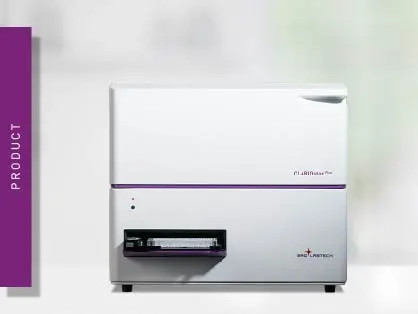
CLARIOstar Plus
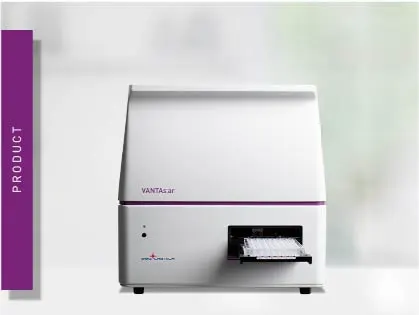
VANTAstar
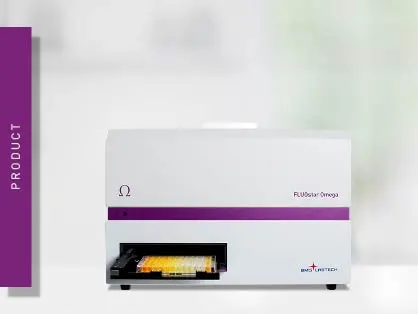
Omega Series
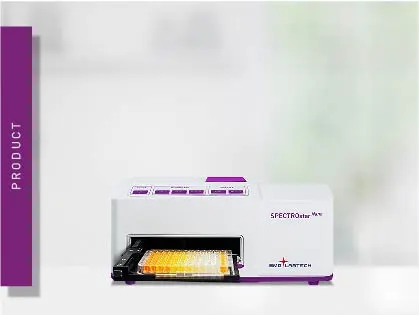
SPECTROstar Nano
Which assays can be measured by an absorbance microplate reader?
Absorbance is one of the most popular detection modes for life science applications. Accordingly, there is a multitude of kits and reagents available on the market that an absorbance microplate reader can cover both as single- or multi-mode instrument. Several colorimetric assays have been adapted to plates or directly developed for use in a microplate reader.
One of the most common applications is DNA/RNA quantification at 260 nm. It is also possible to quantify a specific protein in solution, typically by enzyme-linked immunosorbent assay (ELISA). Several colorimetric methods are also available for protein quantification. In our blog article “Protein measurement: find a suitable method” you will find detailed descriptions of protein quantification assays such as Bradford, BCA and tips to help you choose.
Another application absorbance microplate reader can measure is cell growth in bacteria and yeast by measuring the “optical density at 600 nm” (OD600) or cell viability by colorimetric assays.
Examples of measurements with BMG LABTECH absorbance microplate readers:
The following are examples of absorbance measurements taken on BMG LABTECH microplate readers:
- AN 362: DNA purity ratio – fast and easy absorbance-based evaluation of nucleic acid quality
- AN 341: Highly sensitive ELISAs in 90 minutes: SimpleStep ELISA kits and the SPECTROstar Nano
- AN 299: Absorbance-based methods for protein quantification on BMG LABTECH instrumentsAN 303: Detection of plant-synthesized nanoparticles and their antibacterial capacity
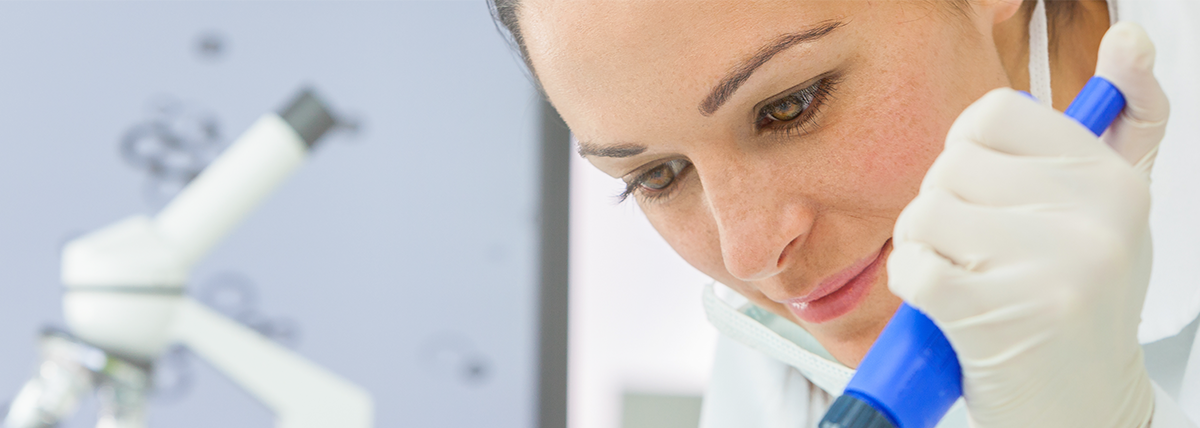
Why to choose a BMG LABTECH absorbance microplate reader?
BMG LABTECH is specialised in producing microplate readers only and brings more than 30 years of full expertise in microplate reading technology. This knowledge gets visible in the results that our instruments deliver - the only factor that counts in your lab! Our users can trust to obtain best results in sensitivity, speed and flexibility. Moreover, our single and multi-mode plate readers are developed to provide optimum performance for years. Our instruments are developed, produced and tested in Germany and are built to be extremely robust and reliable.
Buy only what you need
Due to their modularity, all our multimode plate readers can be equipped with different detection modes and cover a multitude of applications. Additional features can be upgraded. This gives you the chance to keep your options open even if you don’t use the full scope of your microplate reader right at the bat.
All-round service and support
We strive to provide you with the very best customer service and support. If you need customer support, we are only a phone call or email away. During business hours, you immediately speak live to a person who is happy to assist. There is no automated phone system or waiting in a queue. Our scientists, engineers and technicians are always there to help.
Multi-user software package
All our instruments come with a multi-user software package that can be installed on as many computers as users requires, without the need to purchase licenses. Software updates for our microplate readers are of no charge within the first 12 month after purchase.




